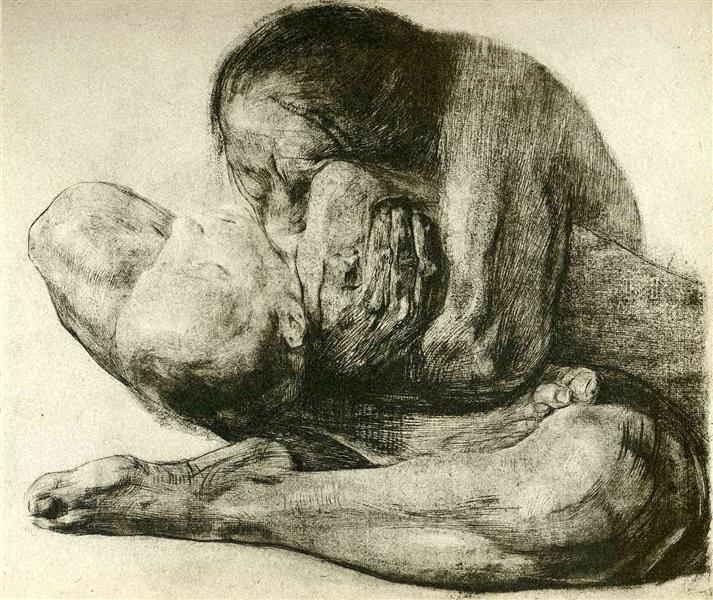Description
The work "woman with a dead child" (1903) by Käthe Kollwitz is one of the most forceful expressions of pain and the loss that crosses human experience. This painting, which illustrates the relationship between a mother and her deceased son, connects with one of the most recurring themes in Kollwitz's work: maternal suffering before the tragedy of death. The artist, known for her sensitivity to the working classes and for her commitment to denounce the social evils of her time, achieves in this piece capture the forceful anguish that a mother experiences in her son's face and her own reflection of despair.
The composition of the work is remarkable for its simplicity and strength. The figure of the woman, who occupies most of the canvas, is presented with a monumental character, projecting a powerful aura despite the fragility of her condition. His expression is that of a deep sadness, evident in the eyes and lines of his face, which seem to convey not only their personal pain, but an echo of collective suffering that resonates among the women of their time. Kollwitz uses a masterful use of space, with a figure that unfolds almost in all its height, making the viewer feel immersed in the tragedy that is being represented.
The color, in its predilection for a gloomy and terrous palette, contributes to the dramatic weight of the work. The dark tones predominate, generating an atmosphere of mourning and sadness. The texture also plays a crucial role; Although the Kollwitz technique is mostly drawing and lithography, this painting shows a loose and fastened brushstroke that highlights the emotional load of the scene. Through the shadow and the subtly nuanced light, the artist guides the viewer's gaze, creating a dialogue between the figure of the mother and that of the fallen child.
The infant, in his fragility, seems to be placid, as if he had found peace in his departure, while the mother expresses an infinite tear. This duality resents the connection between life and death, enhancing the tragedy of separation. The relationship between them is not limited to the visual; It begins to resonate in the heart of the viewer, invoking a broader reflection on the duel and loss that is not only personal, but also a social phenomenon exacerbated in times of war and hardship.
Käthe Kollwitz, whose work often reflects his social activism and his empathy towards those who suffer, achieves in this piece perfectly embody the experience of thousands of women who have faced the loss of a child. This work is not only a portrait of a mother in duel, but a claim of the existential struggle that all those who face the death of a loved one are going through. In the context of the art of the early twentieth century, "woman with a dead child" rises as a visual cry that challenges the soul, reminding us of the fragility of life and the unavoidable reality of suffering.
Kollwitz's expressionist style, characterized by the visceral representation of the human condition, is revealed in this work. His ability to articulate pain through form and emotion is also found in other of his outstanding works such as "the mother" and "The dead", where the theme of maternal suffering and the burden of loss is repeated. Thus, "woman with a dead child" is not only a central work in Kollwitz's trajectory, but also constitutes a milestone in art history, a permanent reminder of empathy and human connection in times of despair.
KUADROS ©, a famous paint on your wall.
Hand-made oil painting reproductions, with the quality of professional artists and the distinctive seal of KUADROS ©.
Art reproduction service with satisfaction guarantee. If you are not completely satisfied with the replica of your painting, we refund your money 100%.

